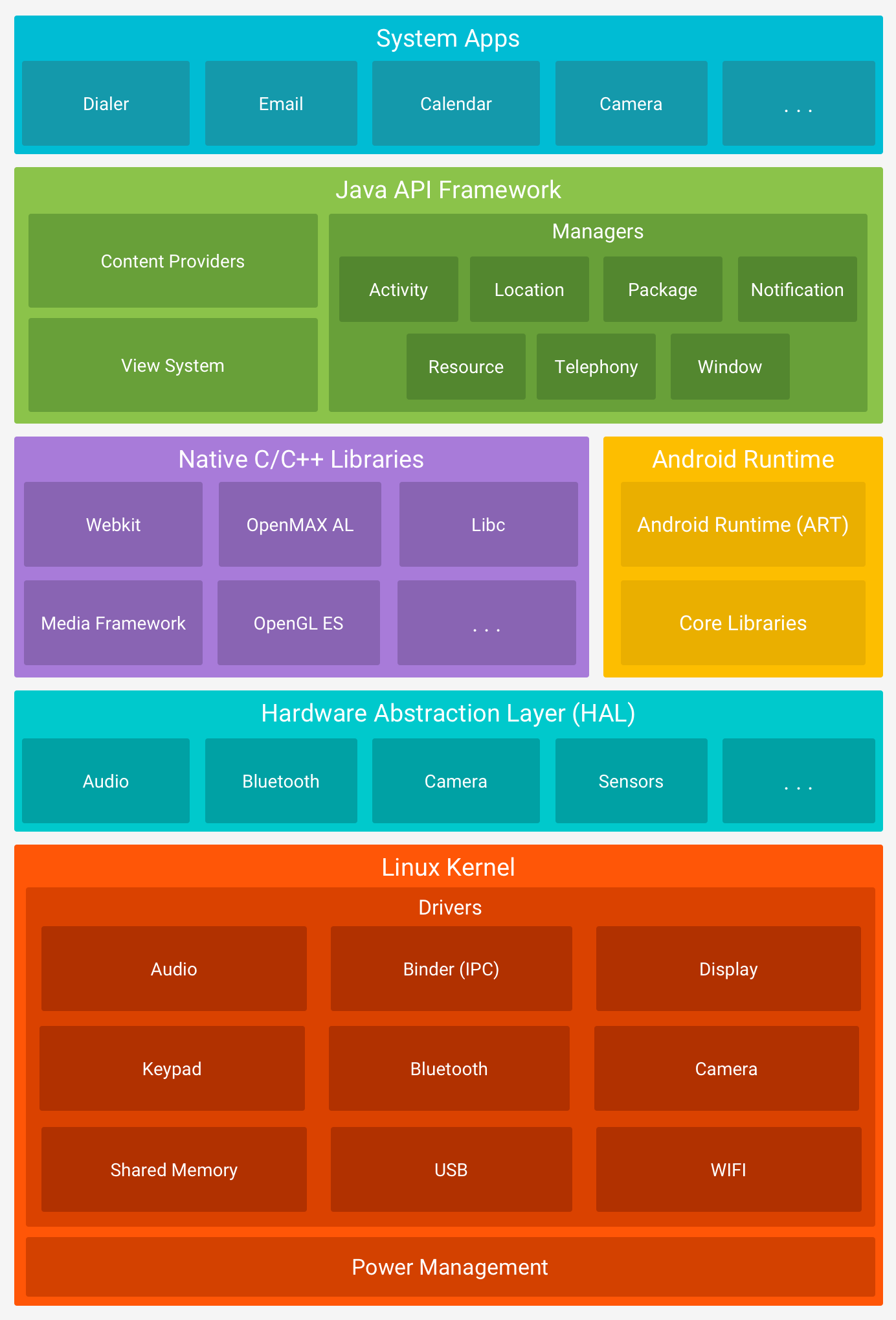Android 是一个基于 Linux 的开源软件堆栈,针对多种不同设备类型打造。图 1 显示了 Android 平台的主要组件。

图 1. Android 软件堆栈。
Linux 内核
Android 平台的基础是 Linux 内核。例如,Android 运行时 (ART) 依赖 Linux 内核来实现底层功能,例如线程处理和低级内存管理。
使用 Linux 内核可让 Android 利用关键安全功能,并让设备制造商能够为知名内核开发硬件驱动程序。
硬件抽象层 (HAL)
硬件抽象层 (HAL) 提供了用于向较高级别的 Java API 框架公开设备硬件功能的标准接口。HAL 由多个库模块组成,每个模块都为特定类型的硬件组件(例如相机或蓝牙模块)实现一个接口。当框架 API 发出调用以访问设备硬件时,Android 系统将为该硬件组件加载库模块。
Android 运行时
对于搭载 Android 5.0(API 级别 21)或更高版本的设备,每个应用都在其自己的进程中运行,并且有其自己的 Android 运行时 (ART) 实例。ART 编写为通过执行 Dalvik 可执行文件格式 (DEX) 文件,在低内存设备上运行多个虚拟机。DEX 文件是一种专为 Android 设计的字节码格式,针对最小的内存占用量进行了优化。构建工具(如 d8)可将 Java 源代码编译成 DEX 字节码,此类字节码可在 Android 平台上运行。
ART 的部分主要功能包括:
- 预先 (AOT) 和即时 (JIT) 编译
- 优化的垃圾回收 (GC)
- 在 Android 9(API 级别 28)及更高版本中,可将应用软件包的 DEX 文件转换为更紧凑的机器代码
- 可提供更好的调试支持,包括专用采样剖析器、详细的诊断异常和崩溃报告,以及设置观察点以监控特定字段的能力
在 Android 版本 5.0(API 级别 21)之前,Dalvik 是 Android 运行时。如果您的应用在 ART 上运行良好,那么它也可以在 Dalvik 上运行,但反过来不一定。
Android 还包含一套核心运行时库,可提供 Java API 框架所使用的 Java 编程语言中的大部分功能,包括一些 Java 8 语言功能。
原生 C/C++ 库
许多核心 Android 系统组件和服务(如 ART 和 HAL)都是从需要用 C 和 C++ 编写的原生库的原生代码构建的。Android 平台提供 Java 框架 API,用于向应用提供其中一些原生库的功能。例如,您可以通过 Android 框架的 Java OpenGL API 访问 OpenGL ES,以支持在应用中绘制和操控 2D 和 3D 图形。
如果开发的是需要 C 或 C++ 代码的应用,可以使用 Android NDK 直接从原生代码访问某些原生平台库。
Java API 框架
您可通过以 Java 语言编写的 API 使用 Android 操作系统的整个功能集。这些 API 是创建 Android 应用所需的构建块的基础,可简化核心、模块系统组件和服务的重复使用,包括以下组件和服务:
- 丰富且可扩展的视图系统,可用于构建应用界面,包括列表、网格、文本框、按钮,甚至可嵌入的网络浏览器
- 资源管理器,用于访问非代码资源,例如本地化的字符串、图形和布局文件
- 通知管理器,可让所有应用在状态栏中显示自定义提醒
- 一个 activity 管理器,用于管理应用的生命周期,并提供常见的导航返回堆栈
- Content Provider,可让应用访问其他应用(例如“通讯录”应用)中的数据或共享自己的数据
开发者可以完全访问 Android 系统应用使用的相同框架 API。
系统应用
Android 随附一套用于电子邮件、短信、日历、互联网浏览和通讯录等的核心应用。平台随附的应用与用户可以选择安装的应用一样,没有特殊状态。因此,第三方应用可以成为用户的默认网络浏览器、短信应用甚至默认键盘。但有一些例外情况,例如系统的“设置”应用。
系统应用既可用作用户体验应用,又能提供开发者可从自己的应用访问的关键功能。例如,如果您希望应用发送短信,则无需自行构建该功能。您可以改为调用已安装的短信应用,将消息发送给您指定的接收者。

